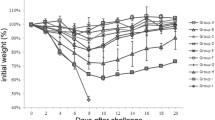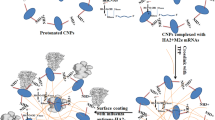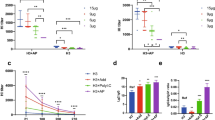Abstract
Our previous studies have proven the adjuvanticity of chitosan in mice when administered with inactivated and subunit influenza vaccine. In this study, we investigated the adjuvant effect of chitosan on the immunogenicity and protective efficacy of a live attenuated influenza vaccine. Mice were inoculated intranasally with live attenuated influenza vaccine plus chitosan and then challenged with a high, lethal dose of homologous or heterologous virus. Antibody responses, secretion of IFN-γ by spleen cells, body weight loss, survival rates, and residual lung virus titers were tested. The results demonstrated that live attenuated influenza vaccine with chitosan adjuvant not only protected mice completely against challenge with the homologous virus but also provided good cross-protection against a heterologous virus. In addition, chitosan as adjuvant could significantly increase the levels of antigen-specific antibodies and the population of IFN-γ-secreting T cells. These results reveal the potential of chitosan as a candidate adjuvant for use in a live attenuated influenza vaccine.




Similar content being viewed by others
References
Nichol KL, Treanor JJ (2006) Vaccines for seasonal and pandemic influenza. J Infect Dis 194:S111–S118
Belshe RB, Gruber WC, Mendelman PM, Mehta HB, Mahmood K, Reisinger K et al (2000) Correlates of immune protection induced by live, attenuated, cold-adapted, trivalent, intranasal influenza virus vaccine. J Infect Dis 181:1133–1137
Cox RJ, Brokstad KA, Ogra P (2004) Influenza virus: immunity and vaccination strategies. Comparison of the immune response to inactivated and live, attenuated influenza vaccines. Scand J Immunol 59:1–15
Stepanova L, Naykhin A, Kolmskog C, Jonson G, Barantceva I, Bichurina M et al (2002) The humoral response to live and inactivated influenza vaccines administered alone and in combination to young adults and elderly. J Clin Virol 24:193–201
Mendelman PM, Cordova J, Cho I (2001) Safety, efficacy and effectiveness of the influenza virus vaccine, trivalent, types A and B, live, cold-adapted (CAIV-T) in healthy children and healthy adults. Vaccine 19:2221–2226
Ferko B, Kittel C, Romanova J, Sereinig S, Katinger H, Egorov A (2006) Live attenuated influenza virus expressing human interleukin-2 reveals increased immunogenic potential in young and aged hosts. J Virol 80:11621–11627
Kopecky-Bromberg SA, Fraser KA, Pica N, Carnero E, Moran TM, Franck RW et al (2009) Alpha-C-galactosylceramide as an adjuvant for a live attenuated influenza virus vaccine. Vaccine 27:3766–3774
Tamura SI, Kurata T (2000) A proposal for safety standards for human use of cholera toxin (or Escherichia coli heat-labile enterotoxin) derivatives as an adjuvant of nasal inactivated influenza vaccine. Jpn J Infect Dis 53:98–106
Illum L (1998) Chitosan and its use as a pharmaceutical excipient. Pharm Res 15:1326–1331
Singla AK, Chawla M (2001) Chitosan: some pharmaceutical and biological aspects–an update. J Pharm Pharmacol 53:1047–1067
No HK, Meyers SP, Prinyawiwatkul W, Xu Z (2007) Applications of chitosan for improvement of quality and shelf life of foods: a review. J Food Sci 72:R87–R100
Rauw F, Gardin Y, Palya V, Anbari S, Gonze M, Lemaire S et al (2009) The positive adjuvant effect of chitosan on antigen-specific cell-mediated immunity after chickens vaccination with live Newcastle disease vaccine. Vet Immunol Immunop 134:249–258
Rauw F, Gardin Y, Palya V, Anbari S, Lemaire S, Boschmans M et al (2010) Improved vaccination against Newcastle disease by an in ovo recombinant HVT-ND combined with an adjuvanted live vaccine at day-old. Vaccine 28:823–833
Bacon A, Makin J, Sizer PJ, Jabbal-Gill I, Hinchcliffe M, Illum L et al (2000) Carbohydrate biopolymers enhance antibody responses to mucosally delivered vaccine antigens. Infect Immun 68:5764–5770
Chang H, Li X, Teng Y, Liang Y, Peng B, Fang F et al (2010) Comparison of adjuvant efficacy of chitosan and aluminum hydroxide for intraperitoneally administered inactivated influenza H5N1 vaccine. DNA Cell Biol 29:563–568
Ghendon Y, Markushin S, Krivtsov G, Akopova I (2008) Chitosan as an adjuvant for parenterally administered inactivated influenza vaccines. Arch Virol 153:831–837
Ghendon Y, Markushin S, Vasiliev Y, Akopova I, Koptiaeva I, Krivtsov G et al (2009) Evaluation of properties of chitosan as an adjuvant for inactivated influenza vaccines administered parenterally. J Med Virol 81:494–506
Illum L, Jabbal-Gill I, Hinchcliffe M, Fisher AN, Davis SS (2001) Chitosan as a novel nasal delivery system for vaccines. Adv Drug Deliver Rev 51:81–96
Read RC, Naylor SC, Potter CW, Bond J, Jabbal-Gill I, Fisher A et al (2005) Effective nasal influenza vaccine delivery using chitosan. Vaccine 23:4367–4774
Qiu M, Fang F, Chen Y, Wang H, Chen Q, Chang H et al (2006) Protection against avian influenza H9N2 virus challenge by immunization with hemagglutinin- or neuraminidase-expressing DNA in BALB/c mice. Biochem Bioph Res Co 343:1124–1131
Hoffmann E, Stech J, Guan Y, Webster RG, Perez DR (2001) Universal primer set for the full-length amplification of all influenza A viruses. Arch Virol 146:2275–2289
Hoffmann E, Neumann G, Kawaoka Y, Hobom G, Webster RG (2000) A DNA transfection system for generation of influenza A virus from eight plasmids. Proc Natl Acad Sci USA 97:6108–6113
Jin H, Zhou H, Lu B, Kemble G (2004) Imparting temperature sensitivity and attenuation in ferrets to A/Puerto Rico/8/34 influenza virus by transferring the genetic signature for temperature sensitivity from cold-adapted A/Ann Arbor/6/60. J Virol 78:995–998
Neumann G, Watanabe T, Ito H, Watanabe S, Goto H, Gao P et al (1999) Generation of influenza A viruses entirely from cloned cDNAs. Proc Natl Acad Sci USA 96:9345–9350
Chen J, Fang F, Li X, Chang H, Chen Z (2005) Protection against influenza virus infection in BALB/c mice immunized with a single dose of neuraminidase-expressing DNAs by electroporation. Vaccine 23:4322–4328
Chen H, Matsuoka Y, Swayne D, Chen Q, Cox NJ, Murphy BR et al (2003) Generation and characterization of a cold-adapted influenza A H9N2 reassortant as a live pandemic influenza virus vaccine candidate. Vaccine 21:4430–4436
Jabbal-Gill I, Fisher AN, Rappuoli R, Davis SS, Illum L (1998) Stimulation of mucosal and systemic antibody responses against Bordetella pertussis filamentous haemagglutinin and recombinant pertussis toxin after nasal administration with chitosan in mice. Vaccine 16:2039–2046
McNeela EA, O’Connor D, Jabbal-Gill I, Illum L, Davis SS, Pizza M et al (2000) A mucosal vaccine against diphtheria: formulation of cross reacting material (CRM(197)) of diphtheria toxin with chitosan enhances local and systemic antibody and Th2 responses following nasal delivery. Vaccine 19:1188–1198
Westerink MA, Smithson SL, Srivastava N, Blonder J, Coeshott C, Rosenthal GJ (2001) ProJuvant (Pluronic F127/chitosan) enhances the immune response to intranasally administered tetanus toxoid. Vaccine 20:711–723
Fazekas G, Rosenwirth B, Dukor P, Gergely J, Rajnavolgyi E (1994) IgG isotype distribution of local and systemic immune responses induced by influenza virus infection. Eur J Immunol 24:3063–3067
Bungener L, Geeraedts F, Ter Veer W, Medema J, Wilschut J, Huckriede A (2008) Alum boosts TH2-type antibody responses to whole-inactivated virus influenza vaccine in mice but does not confer superior protection. Vaccine 26:2350–2359
Szyszko E, Brokstad K, Cox RJ, Hovden AO, Madhun A, Haaheim LR (2006) Impact of influenza vaccine formulation with a detailed analysis of the cytokine response. Scand J Immunol 64:467–475
Zaharoff DA, Rogers CJ, Hance KW, Schlom J, Greiner JW (2007) Chitosan solution enhances both humoral and cell-mediated immune responses to subcutaneous vaccination. Vaccine 25:2085–2094
Huber VC, McKeon RM, Brackin MN, Miller LA, Keating R, Brown SA et al (2006) Distinct contributions of vaccine-induced immunoglobulin G1 (IgG1) and IgG2a antibodies to protective immunity against influenza. Clin Vaccine Immunol 13:981–990
Moran TM, Park H, Fernandez-Sesma A, Schulman JL (1999) Th2 responses to inactivated influenza virus can Be converted to Th1 responses and facilitate recovery from heterosubtypic virus infection. J Infect Dis 180:579–585
Sui Z, Chen Q, Fang F, Zheng M, Chen Z (2010) Cross-protection against influenza virus infection by intranasal administration of M1-based vaccine with chitosan as an adjuvant. Vaccine 28:7690–7698
Sui Z, Chen Q, Wu R, Zhang H, Zheng M, Wang H et al (2010) Cross-protection against influenza virus infection by intranasal administration of M2-based vaccine with chitosan as an adjuvant. Arch Virol 155:535–544
Aspden TJ, Mason JD, Jones NS, Lowe J, Skaugrud O, Illum L (1997) Chitosan as a nasal delivery system: the effect of chitosan solutions on in vitro and in vivo mucociliary transport rates in human turbinates and volunteers. J Pharm Sci 86:509–513
Davis SS, Illum L (2003) Absorption enhancers for nasal drug delivery. Clin Pharmacokinet 42:1107–1128
van der Lubben IM, Verhoef JC, Borchard G, Junginger HE (2001) Chitosan and its derivatives in mucosal drug and vaccine delivery. Eur J Pharm Sci 14:201–207
Chen CL, Wang YM, Liu CF, Wang JY (2008) The effect of water-soluble chitosan on macrophage activation and the attenuation of mite allergen-induced airway inflammation. Biomaterials 29:2173–2182
Mori T, Murakami M, Okumura M, Kadosawa T, Uede T, Fujinaga T (2005) Mechanism of macrophage activation by chitin derivatives. J Vet Med Sci 67:51–56
Nishimura K, Nishimura S, Nishi N, Saiki I, Tokura S, Azuma I (1984) Immunological activity of chitin and its derivatives. Vaccine 2:93–99
Peluso G, Petillo O, Ranieri M, Santin M, Ambrosio L, Calabro D et al (1994) Chitosan-mediated stimulation of macrophage function. Biomaterials 15:1215–1220
van Ginkel FW, Jackson RJ, Yoshino N, Hagiwara Y, Metzger DJ, Connell TD et al (2005) Enterotoxin-based mucosal adjuvants alter antigen trafficking and induce inflammatory responses in the nasal tract. Infect Immun 73:6892–6902
Mutsch M, Zhou W, Rhodes P, Bopp M, Chen RT, Linder T et al (2004) Use of the inactivated intranasal influenza vaccine and the risk of Bell’s palsy in Switzerland. New Engl J Med 350:896–903
Acknowledgements
This study was supported by the following research funds: National High Technology Research and Development Program of China (863 Program 2010AA022905 and 2010AA022908); National 973 Project (2010CB530301); National Natural Science Foundation of China (No. 81071346 and No. 81172738). We thank R. G. Webster (from St. Jude Children’s Research Hospital, Memphis, TN) for the pHW2000 plasmid.
Author information
Authors and Affiliations
Corresponding authors
Rights and permissions
About this article
Cite this article
Wang, X., Zhang, W., Liu, F. et al. Intranasal immunization with live attenuated influenza vaccine plus chitosan as an adjuvant protects mice against homologous and heterologous virus challenge. Arch Virol 157, 1451–1461 (2012). https://doi.org/10.1007/s00705-012-1318-7
Received:
Accepted:
Published:
Issue Date:
DOI: https://doi.org/10.1007/s00705-012-1318-7




